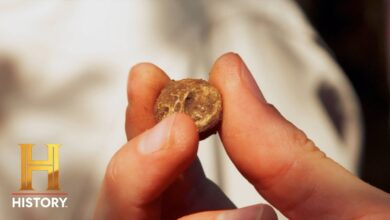The Curse of Oak Island Season 12: Discovering Ancient Muskets
The Curse of Oak Island Season 12: Discovering Ancient Muskets

Hey guys, season 12 of The Curse of Oak Island continues to unravel one of history’s most enigmatic mysteries as the Lagina brothers and their team uncover artifacts and structures that challenge established timelines and historical records. Among the fascinating discoveries is an ancient musket artifact found on Lot 5, which carries profound implications for the origin and purpose of various relics unearthed on the island. This discovery intertwines with tales of treasure, naval expeditions, and military endeavors, offering tantalizing clues to the elusive treasure of Oak Island.
The artifact in question, identified as a ramrod guide from a musket, is a small yet significant find. This component, essential for loading early firearms, likely dates back to the period between the 17th and 18th centuries. Such a timeline aligns intriguingly with other discoveries on the island, including coins, pottery, and lead artifacts from the same era. The team’s analysis revealed unique markings on the ramrod guide, including Roman numerals—an uncommon feature on such items. Roman numerals have previously been associated with larger structures on Oak Island, such as the U-shaped wooden barrier found at Smith’s Cove, believed to be connected to the island’s flood tunnel system. The discovery of these numerals on a personal artifact adds another layer of intrigue, potentially tying individual artifacts to larger, deliberate construction efforts.
The musket artifact also resonates with a historical narrative tied to the Dup d’Enville expedition of 1746. This French naval mission aimed to recapture Nova Scotia from British control. Notably, a ship’s log from this expedition, discovered in the Nova Scotia archives, mentions a secret operation to bury a cache of treasure on an island south of Halifax. This timeline coincides with other artifacts and features found on Oak Island, including the mysterious garden shaft and nearby tunnel, dated to 1735–1804. The musket’s potential connection to this expedition suggests that military personnel involved in the mission may have used or left such items during their activities. If true, this artifact could provide direct evidence linking Oak Island to one of history’s most intriguing treasure-hiding operations.
Lot 5 has emerged as a treasure trove of artifacts, including ancient Roman coins, lead tokens, and now the musket component. The discovery of this item, alongside the circular depression and mysterious rock structures on the lot, suggests organized activity on the island during the 17th and 18th centuries. These findings align with the team’s working theory that the island served as a staging ground for treasure concealment, possibly involving multiple expeditions across centuries. The patina and craftsmanship of the musket artifact indicate it may belong to a sophisticated, organized group, possibly linked to the French military or other entities with the means and motive to conduct large-scale operations.
Furthermore, the artifact’s presence in Lot 5, far from The Money Pit, raises questions about the scope of activity on Oak Island and its broader purpose. To better understand the artifact, the team employed advanced CT scanning, revealing detailed internal and external features. This scan highlighted Roman numerals carved into the artifact, likely indicating its origin or ownership. Metallurgical analysis of the material may provide further clues about its provenance, potentially linking it to a specific region or military unit. This use of modern technology underscores the interdisciplinary approach required to solve the Oak Island mystery. By combining historical research with scientific tools, the team bridges the gap between speculative theories and concrete evidence.
The musket artifact is not an isolated find. Its discovery adds to a growing body of evidence pointing to organized, purposeful activity on Oak Island. Other related finds include the U-shaped structure discovered at Smith’s Cove. This wooden construction also bore Roman numerals, suggesting a shared origin or purpose with the musket artifact. The garden shaft and tunnel, the tunnel beneath the garden shaft scientifically dated to as early as 1735, aligns with the timeline of the musket artifact. The vertical wood beams discovered in the tunnel further confirm its man-made origin, possibly linked to treasure burial efforts. Ancient coins and lead artifacts, the discovery of Roman coins and a lead barter token matching the lead cross found in 2017, suggests a blend of historical layers with artifacts spanning different eras and regions.
The musket artifact bolsters the theory that Oak Island was a site of deliberate treasure concealment. The presence of military-related items, coupled with evidence of large-scale engineering projects like tunnels and shafts, suggests an operation requiring significant resources and expertise. If the artifact indeed belonged to participants in the Duke D’Enville expedition, it may confirm historical accounts of treasure being hidden to protect it from British forces. Alternatively, the artifact could point to other groups, such as pirates, privateers, or secretive organizations like the Knights Templar, who are often speculated to have played a role in the island’s history. The artifact’s military nature and craftsmanship may provide the key to narrowing down these possibilities.
The discovery of the musket artifact represents one more piece in the vast puzzle of Oak Island. As the team continues to investigate Lot 5, The Money Pit, and surrounding areas, they are piecing together a narrative that spans centuries. The convergence of historical documents, advanced technology, and archaeological expertise is driving the search closer to definitive answers. While the musket artifact itself may not be a treasure in the traditional sense, its implications are profound. It serves as a tangible link to the past, providing evidence of the human hands that shaped Oak Island’s enigmatic history. Whether those hands belong to French soldiers, secretive treasure depositors, or another group entirely remains to be seen.
The ancient musket artifact found on Oak Island in season 12 exemplifies the layered complexity of this historical mystery. Its discovery, alongside other artifacts and features, reinforces the idea of Oak Island as a site of significant activity during the 17th and 18th centuries. As the Lagina brothers and their team delve deeper into the island’s secrets, each find—no matter how small—adds to the compelling narrative of treasure exploration and human ingenuity. With every core sample and artifact analysis, the team edges closer to solving a mystery that has captivated the world for over two centuries.
The musket artifact, with its Roman numerals and military implications, could be the clue that ties together centuries of speculation and discovery into a cohesive story of Oak Island’s true purpose. The discovery of the musket artifact with Roman numerals on Lot 5 has sparked renewed speculation about a potential military presence on Oak Island during the mid-1700s. The artifact’s unique markings, coupled with its association with a ramrod guide, suggest it could have belonged to a regiment or a specific individual involved in military activities. This find further aligns with the historical timeline of the Dup d’Enville expedition, a French military operation that included secretive treasure burying endeavors.
The precision of the Roman numerals hints at a purposeful marking, possibly for inventory or identification, adding to the allure of the artifact’s historical and contextual significance. Moreover, the connection to the U-shaped structure at Smith’s Cove, which also bore Roman numerals, cannot be overlooked. This structure, previously believed to be part of a defensive or functional system for The Money Pit, may now have a deeper military connotation. If the artifacts and structures on Lot 5 share a lineage with those at Smith’s Cove, they could collectively point to a coordinated effort by a single group or entity. This group might have been responsible for implementing advanced construction and concealment techniques consistent with treasure burying operations detailed in the Duke D’Enville expedition’s log.
The discovery of substantial wood beams in The Money Pit drill core reinforces the theory of a large, intricate subterranean network beneath Oak Island. The dimensions of the wood and its arrangement suggest it may have been part of a robustly constructed tunnel, further supporting claims of a large-scale operation. Such findings emphasize the island’s historical importance and hint at the presence of highly skilled labor capable of creating long-lasting structures. If this tunnel is indeed connected to the Garden Shaft or extends toward The Money Pit, it may finally bridge the gaps in understanding Oak Island’s underground layout.
The artifacts and structures from Lot 5, combined with the ongoing drilling in The Money Pit, underscore the multidisciplinary approach required to solve the Oak Island mystery. Archaeology, metallurgy, and historical analysis converge to provide a comprehensive picture of past activities. The presence of Roman numerals on multiple artifacts now ties together disparate discoveries across the island, offering a tantalizing clue that the buried treasure may have been the work of a militarily organized expedition rather than random settlers or fortune seekers. This shifts the narrative from speculation to a theory grounded in historical evidence.
As the team moves forward, the potential for groundbreaking discoveries grows. Excavation of the garden shaft and further exploration of the Lot 5 structures could yield more definitive answers. Each artifact uncovered brings the mystery closer to resolution, with the musket artifact now a critical piece of the puzzle. Whether these discoveries lead to hidden treasure, the answer to a historical riddle, or both, the systematic efforts of the Oak Island team continue to captivate audiences and reinforce the enduring allure of the island’s enigmatic past.








